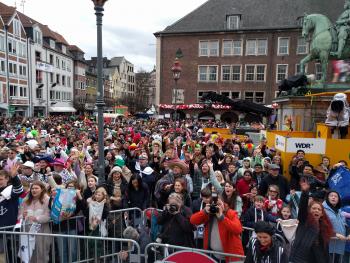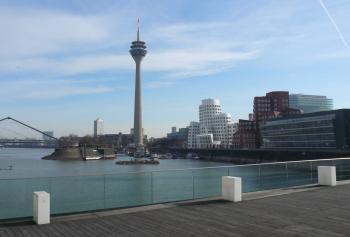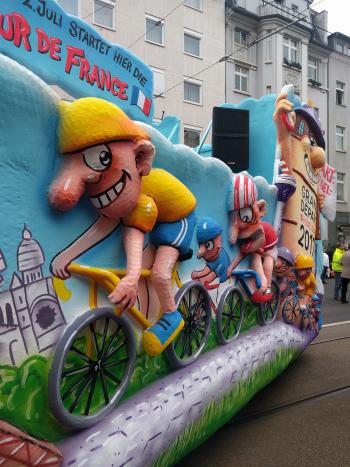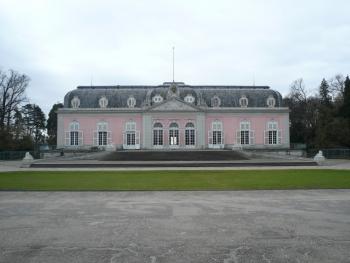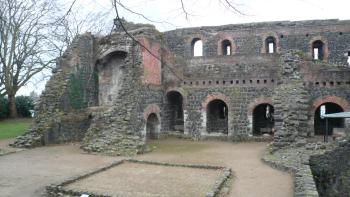Celebrating culture and Karneval in Düsseldorf, Germany
This article appears on page 6 of the July 2017 issue.
There are many cities and sites that spring to mind when considering a trip to Germany — the historical Cold War landmarks of Berlin, reflections of Bavarian culture in Munich or the musical legacy of Leipzig — but Düsseldorf might not make it to the top of most travelers’ lists. However, like Rio, New Orleans and Venice, Düsseldorf has a long tradition of enthusiastically celebrating Carnival (Karneval in Deutschland).
Fortuitously, I was invited to join in the festivities, riding on one of the Rose Monday (Rosenmontag) parade floats, an honor that even longtime residents of the city might not ever receive.
So on Feb. 24, 2017, I flew airberlin nonstop from Los Angeles to Düsseldorf. (A nonstop flight from San Francisco, closer to home for me, began service shortly after my trip, in April.) At 6'3", I appreciated the extra legroom in Economy Plus.
Getting settled
My hotel for the first couple of nights in the city was the 4-star Derag Livinghotel Düsseldorf (Kirchfeldstraße 59-61; phone +49 211 417 290, www.deraghotels.de), located on the Kirchplatz, just east of the Altstadt (Old Town) in a nice neighborhood near shopping and sites of interest.
This cozy hotel is often used for long-term stays, so each room (from €76, or $84, per night) includes a kitchenette complete with a stove and cookware. My favorite part? The contents of the mini-fridge, two bottles of water and two bottles of beer, were complimentary and refilled each day, so don’t be shy about raiding the fridge!
Another neat thing about the Derag is that bees are kept in rooftop hives, and the harvested honey is served at breakfast (€18).
The hotel is just across the street from a central U-Bahn stop, which I used often. I had a DüsseldorfCard, which allowed unlimited rides on all public transportation within the city’s Zone A and offered discounts at museums and other sites. The card comes in 1-, 2- and 3-day periods of validity (€9-€19, or $10-$21), so I needed two to cover my 6-day stay.
That first evening, our group of journalists took a walking tour of the Altstadt and the Rhine Promenade (Rheinuferpromenade). It was there that the serenity of the Kirchplatz gave way to the chaos of Karneval.
It was Friday, three days before the Rose Monday parade, and the city was in full celebration mode.
In Germany, the legal drinking age for wine and beer is 16, and that seemed to be the age of most of the people we encountered as we walked through the very crowded streets of the Old City. Though drunk and overstimulated, everyone remained jovial and welcoming.
That said, the resulting refuse of the days-long celebration was not easy to escape. Wear shoes with solid soles because, throughout the Karneval weekend, the streets of the Altstadt will likely be covered in broken glass. Also, be wary when turning in to small alleys. Let’s just say that there’s a reason that the walls of the nicer buildings are covered with plastic during this time.
Minus the revelers, the Altstadt exuded a typical Northern European feel, with tightly packed brick, wood and plaster buildings, cobbled streets and an air of history.
This area is most famous for its Altbier, a type of beer brewed under Düsseldorf’s centuries-old purity laws. Visitors can find Altbier anywhere in the city, but in the Altstadt, ordering one (or more) is practically required.
City sights
The next morning the streets were empty, with much of the evidence of the previous night’s party swept away. Our first stop for the day was the MedienHafen (Media Harbor), the city’s business center.
Formerly a working shipping harbor on the Rhine, the MedienHafen is now where some of Düsseldorf’s nicest buildings can be found. Many of the buildings retain the original brick, modified with modern glass and metal to create some wonderful “Frankenstein” structures that mix classic charm with modern aesthetics.
There you can also find the most iconic buildings in the city: the massive Rheinturm broadcast tower and three office buildings designed by American architect Frank Gehry.
While the architecture is interesting, the main reason to visit the harbor is to ride to the top of the Rheinturm. We took the elevator to the tower’s observation deck (€9, or €7 with the DüsseldorfCard), 550 feet up, from which the entire city is visible. If you really squint, the spires of the cathedral in Cologne, the tallest spires of any Catholic cathedral in the world, can be seen.
Located directly below the tower, the serpentine curves of the Landtag Nordrhein-Westfalen building (state parliament) are revealed when seen from above, something not visible from the ground level.
The MedienHafen is definitely worth a walk, if not an entire afternoon’s exploration.
The next morning, our group headed south to the very edge of the city to visit Benrath Palace.
Benrath is too far south to be accessible by U-Bahn, but it does have an S-Bahn station nearby. We took a taxi.
Built as a hunting lodge for a local elector (think something like a count) in about 1770, the palace, both inside and out, is intensely Baroque.
The grounds consist of the main hall (with many secret doors, stairways and even entire floors), two long detached wings (former servants’ quarters that are now a museum and shops) and two large gardens that are popular spots for weddings.
Tours (€14) are available, and if you happen to get a guide who likes to take visitors behind the scenes, it’s definitely worth it. The most interesting sights in the palace — a hidden alcove with a carved plaster wall and the servants’ hallway that wraps around the hollow dome — are not always visited by groups.
When touring the palace, wool slippers must be worn over your shoes to avoid scuffing the original wood floor. It was slippery, so we all resorted to sliding across the floor instead of walking properly.
Time for a parade
That night we moved to the Derag Livinghotel De Medici (Mühlenstraße 31), located right in the heart of the Altstadt. Though it was in the same family of hotels as our previous hotel, De Medici was an entirely different creature. Rooms were far more luxurious, and the hotel offered amenities like a spa and a cigar room. (Rooms start at €198 per night.)
A personal project of the hotel chain’s owner, De Medici, a former monastery (it is still attached to a working church), is full of the owner’s private collection of figural religious art.
The door to my room was sandwiched between two full-size wooden carvings that dated back to the 15th century.
The hotel is somewhat famous in the city for its art, including its collection of walking canes and tobacco pipes; they even offer art tours.
This was the night before Rosenmontag, and the city was by far more crowded than it was on any other night I spent there. Just trying to walk back to my hotel through the Altstadt was a challenge.
The police presence was heavy (my bag was checked three times before I made it to the hotel), and that seemed to keep the crowds under some control. Even though De Medici was right in the middle of it all, my room was quiet and I slept with no issues.
Before I knew it, Rosenmontag had arrived. The float I was invited to ride on had a Tour de France theme. (The famous cycle race will begin in Düsseldorf this year, on July 1). The members of my group were dressed as champagne bottles, and we were joined by locals in bicycling gear.
It was cloudy but warm, and there was little risk of rain, allaying the fears of those worried about a repeat of the rain that canceled the 2016 parade.
Düsseldorf’s parade is a lengthy one. We were float 40 of about 60. After nearly two hours of waiting for our turn to take off, we finally started moving. For about two blocks, we passed other floats and parade participants, then suddenly we were in the midst of the crowds.
People were standing 10 to 15 deep along the roadside, the children right at the front, bags open, calling for candy. Most people were in costume.
Helau!
I should note that Karneval traditions are very well defined, and it’s important to get them right. In Düsseldorf, the traditional greeting/candy request is “Helau!” In Cologne, which has an even larger Karneval parade, the greeting is “Alaaf!” From what I hear, yelling either in the wrong city is liable to get you kicked out of town, as the cities have a friendly but very serious rivalry.
Another thing to understand is how proud the residents are of how provocative their floats are. If very graphic political commentary is not for you, I’d suggest skipping this particular parade.
Also, if you do join the crowds, keep your eyes open. The riders on the floats throw candy and gifts with abandon, and if you aren’t looking, you will probably get hit with something.
From my high perch, it was my job to throw candy and prizes to all the people waving and yelling a hearty “Helau!” It seemed the entire city was out to watch us, and the number of children was amazing.
To say that people were in a festive mood would be an understatement. For more than three hours, we danced and threw candy until, with about four more blocks to go, we ran out.
Being able to be a part of the parade was a unique and exciting experience, but I can’t help but feel that I missed out on the energy and atmosphere of being in the crowd. Still, it was an honor, and something I will never forget.
Outside the city
With the main event over, I wanted to make the most of the free time I had left.
The part of traveling that I love the most is exploring the areas to be found outside of whatever city I’m visiting, so I made my way to Kaiserswerth, a quaint suburb in the northern part of Düsseldorf with cobbled streets and provincial architecture. Kaiserswerth sits directly on an attractive bend of the Rhine River and is accessible via the U-Bahn.
The ruins of the Barbarossa-Pfalz, or Barbarossa Fortress, is Kaiserswerth’s main attraction. This once-impressive fort on the Rhine was built by Holy Roman Emperor Frederick Barbarossa sometime in the 12th century. Not much of the fort remains, but what is left indicates how impressively large the fort must have been in its heyday. Unfortunately, when I visited, the site was closed (it is open to visitors from May through October), but I could see that the ruins had modern railings and stairs.
In addition to the ruins and some nice shops, I found an interesting World War I cemetery in the suburb’s center.
Another place worth visiting is Neandertal, a valley just east of the city. Famous for the hominid that was found there and took its name, Homo neanderthalensis, the area now boasts an impressive hominid museum. A short S-Bahn ride from Düsseldorf’s Hauptbahnhof takes you within walking distance of the museum. Just head downhill from the station and you’re there.
The Neanderthal Museum (Talstraßs 300, Mettmann) is dedicated to the evolution of hominids, from the first bipedal ape to modern humans. One of the highlights is the exhibit of realistic reproductions of various early human species. An audio tour, in English, is available.
The museum is very interactive and designed to keep children engaged, but it should be of interest to any amateur anthropologist. Despite being dedicated to one of the most important discoveries in Germany, the museum is privately run, not state-run like most other major museums in the area, and the entire €9 entry fee goes directly to the museum.
A short distance away from the museum is a park dedicated to the “discovery site.” In actuality, the discovery site no longer exists. You see, Neandertal used to be a beautiful, sheer-cliffed limestone valley carved out by the Düssel River. Unfortunately, excessive quarrying has flattened the area quite a bit.
It was during the quarrying that the Neanderthal skeleton was found in a cave, which is now long gone. However, when searching for rubble from that cave, modern anthropologists found additional bone fragments from that same skeleton, and it is the site of that find that the park now occupies.
The walk from the museum to the park is littered with small monuments into which you can plug the headphones provided for the museum’s audio tour for more information about the valley and the discovery.
Meals and museums
At the beginning of my trip to Düsseldorf, I didn’t know what to anticipate, but I found that there is a lot to appreciate about the city.
If you like good food, the city offers some excellent places to dine. On my first night, our group ate at Brauerei zum Schiffchen (Hafenstraße 5; brauerei-zum-schiffchen.de), purportedly in operation since the 1600s, making it Düsseldorf’s oldest restaurant. The menu features traditional Rhenish cuisine. I had an entreé of oxtail (around €23), and it was very good.
Both of our hotels had restaurants attached: Reul’s Restaurant at the Livinghotel and Brasserie Stadthaus at De Medici. Both were excellent.
If you like shopping, well, there’s an absolute ton of it. Düsseldorf is one of the wealthiest cities in Germany and is considered the fashion capital of the country. That designation is made abundantly clear on the city’s two shopping streets, Königsallee and Schadowstraße. I’ve visited more than a few trendy cities, but I don’t think I’ve ever seen such a concentration of designer-brand stores.
Culture, too, abounds in the city. Within walking distance of De Medici was a smorgasbord of museums. The most interesting, to me, were the Kunst im Tunnel, a pedestrian tunnel that runs underneath the Rhine Promenade and has been turned into an exhibition space for contemporary art; the Kunstsammlung Ständehaus, commonly called K21, the Kunstsammlung Grabbeplatz, aka K20, and the Museum Kunstpalast.
Both K20 and K21 exhibit art from the collections of the state of Nordrhein-Westfalen, with K21 leaning more toward contemporary art. K20 has a surprising number of works by Picasso, some nice Mirós and a collection of paintings by Magritte. Both regularly have temporary exhibits.
At the Kunstpalast, you can find more classical art and a glass museum as well.
Sadly, while I was there, one of the main reasons to visit the K21, an installation entitled “in orbit,” in which visitors climb around on a net strung across the ceiling, was closed for construction.
Getting to ride on a Karneval float in Düsseldorf was a once-in-a-lifetime experience, but if I go again, I’m definitely joining the crowds (and taking a bag for catching goodies).
Dan Barr was a guest of airberlin (917/261-3165, www.airberlin.com) and Düsseldorf Marketing & Tourismus (phone +49 211 202840, www.duesseldorf-tourismus.de/en).

